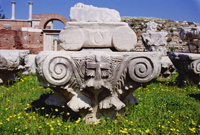 |
 |
|
It is believed that the evangelist St. John had spent his last years in the region around Ephesus and buried in the southern slope of Ayosolug Hill. Three hundred years after the death of Saint Paul , a small chapel was constructed over the grave in the 4th century. The church was changed into a marvelous basilica during the region of Emperor Justinian ( 527 -565 AD). |
|
| The monumental basilica was in the shape of a cross and was covered with six domes. Its construction, being of stone and brick, is an extremely rare find amongst the architecture of its time. Raised by two steps and covered with marble, the tomb of St John was under the central dome, that was once carried by the four columns at the corners. The columns in the courtyard reveals the monograms of Emperor Justinian and his wife Theodora. |
|
 |
|
| Constructed in the 5th century AD , the baptistery is north of the nave , with its key hole shape. Rampart walls around the church were constructed for protection from the Arabian attracts in the 7th - 8th centuries AD. The impressive 10th cent. AD frescoes representing St. John, Jesus and a Saint, ornament the chapel. |
|
 |
|
With the invasion of Turks, the chapel was used as a mosque in the 14th century; unfortunately "Basilica of Saint John" became unusable due to the serious earthquake in the same century. The excavations around the Basilica of Saint John has been continuing under the supervision of Ekrem Akurgal since 1973, with the financial supports of George B. Quatman. |
|
|
 |
|
|
|
|
|